If the word “poetry” makes you think of dead guys with quills or forced rhymes about daffodils, please pause. We need a reboot.
Poetry is one of the most versatile, shape-shifting art forms out there and it’s everywhere, in rap verses, grief journals, love letters, and political protests.
What makes poetry even more fascinating is how many of its types there are.
Over 150 different types of poems are known from different cultures around the world.
And in this article, we talk about the most common types of poetry forms and how you can actually write a poem based on these renowned structures.
Key Takeaways
- Poetry is a way to express emotion, thought, or experience in its rawest, most intentional form, whether it rhymes or not.
- There are many types of poetry, such as sonnet, haiku, limerick, free style, free verse, ode, ghazal, elegy, etc,.
- Different types of poetry suit different moods and messages, and you don’t choose a form at random. You match a type with the tone and feeling you are trying to convey through your poem.
What is Poetry?
Poetry, at its core, is just condensed truth in the philosophical sense of the word.
It’s what happens when someone takes a feeling, a moment, or a thought, breaks it down to its essence, and delivers it in a way that punches you in the gut, gently or otherwise.
Went over the head? Let me explain.
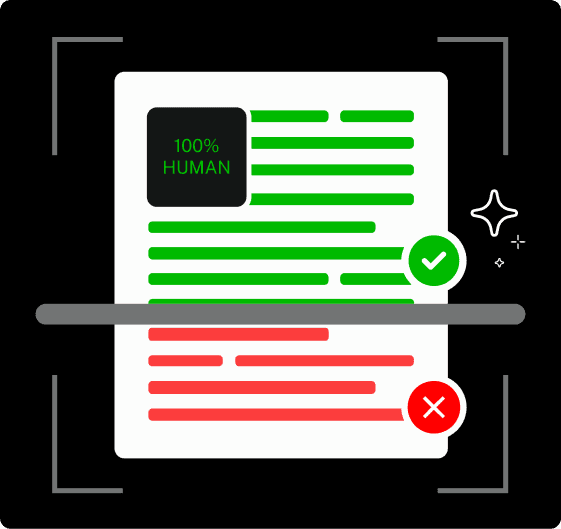
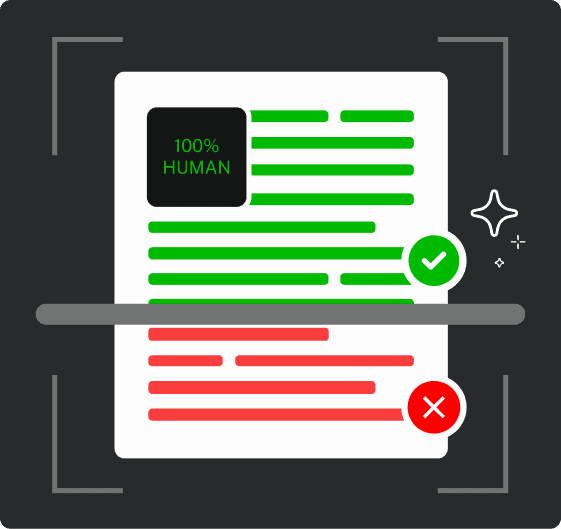
Never Worry About AI Detecting Your Texts Again. Undetectable AI Can Help You:
- Make your AI assisted writing appear human-like.
- Bypass all major AI detection tools with just one click.
- Use AI safely and confidently in school and work.
When you’re watching a sunset and feel that tug in your chest that’s bittersweet, beautiful, a little sad maybe, you could describe it as, “The sky looked nice.” Sure, that’s technically accurate.
But if someone said, “The sky bruised purple as the sun bled behind the hills,” you’ll feel it hard.
Some poems rhyme, some don’t.
What makes something a poem is intentionality, where every pause, every image, every sound has a purpose.
You don’t need a degree to read or write poetry. You also don’t have to “get it” in some academic sense. If it hits you, it hits you.
But ofcourse that doesn’t mean every rhythmic sentence is poetry or anybody can do it naturally.
Like any other art form, it takes time, patience and a lot of practice to write decent poetry.
Types of Poetry with Examples
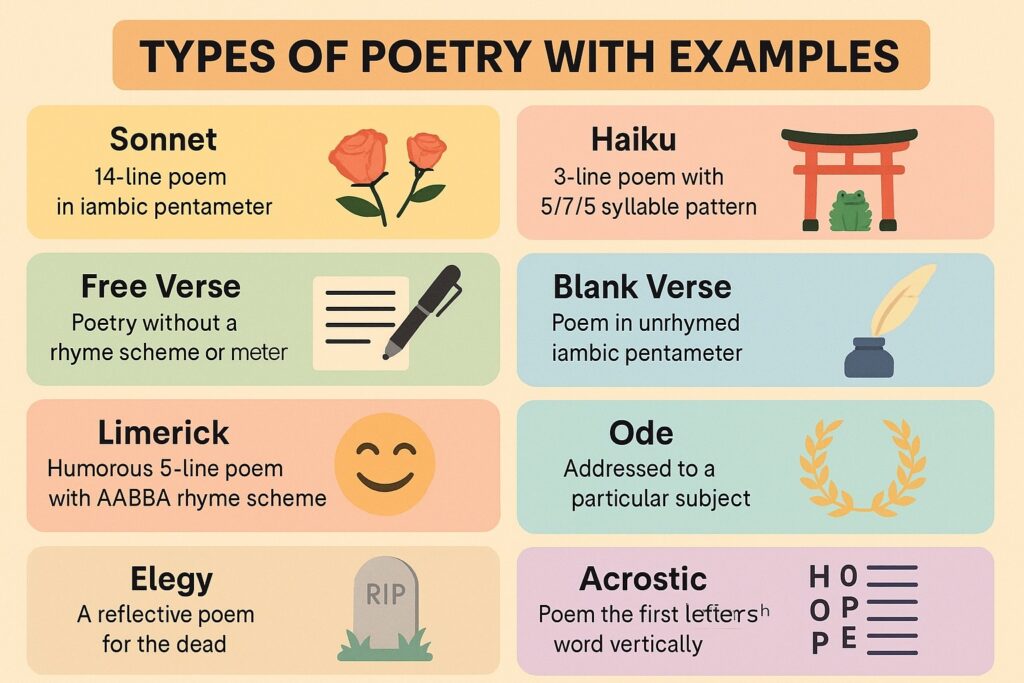
There are many different types of poetry. Let’s look at the common ones:
- Sonnet
Often, when people think of poetry, their brain jumps to Shakespeare mumbling about “thy love” and “roses” and such. And yep, that’s a sonnet.
A sonnet is a 14-line poem traditionally written in iambic pentameter (which is a fancy way of saying: each line has 10 syllables, alternating unstressed and stressed beats, like a heartbeat: da-DUM da-DUM da-DUM da-DUM da-DUM). It is made of:
- 3 quatrains (that’s three 4-line stanzas)
- 1 couplet (a 2-line mic-drop at the end)
Shakespeare’s “Shall I compare thee to a summer’s day” is a classic example of a sonnet.
- Haiku
A Haiku is a very short poem with just 3 lines and 17 syllables arranged in a 5 / 7 / 5 pattern. Haikus originated in Japan in the 1600s and were originally about nature and seasonal change.
Modern haikus, however, cover everything from heartbreak to hangovers.
Here’s an example of a Haiku by Matsuo Bashō:
An old silent pond
A frog jumps into the pond—
Splash! Silence again.
What’s genius here is the contrast. The sudden sound in silence, the momentary disruption that makes you feel the stillness within the poetry even more.
- Free Verse
Free verse is poetry that throws out traditional forms. It does not follow any rhyme schemes or strict stanza lengths.
Instead, it moves the way real thoughts and feelings move: in fragments, in rushes, in pauses, in sudden turns.
Free verse gives poets the flexibility to let the content dictate the shape. Take Walt Whitman, for instance. He’s often credited with popularizing free verse in English poetry. In “Song of Myself,” he opens with:
I celebrate myself, and sing myself
And what I assume you shall assume
For every atom belonging to me as good belongs to you.
Notice how there’s no rhyme or tight meter in the poem. That is not to say free verse is just prose with line breaks. It certainly is not. Every pause, every sudden shift or drop or echo in the poem is intentional.
- Blank Verse
Blank verse, despite the similar-sounding name, is nothing like free verse. It’s written in unrhymed iambic pentameter, which means each line typically has ten syllables, with alternating unstressed and stressed beats.
The poem does not rhyme at the ends of lines, but it has a formal rhythm running underneath the surface that’s best felt when you read it out loud.
Hamlet’s famous soliloquy is an excellent example of blank verse poetry:
“To be, or not to be—that is the question
Whether ’tis nobler in the mind to suffer
The slings and arrows of outrageous fortune…”
- Limerick
A limerick is a five-line poem with a very specific rhythm and rhyme scheme. It’s short, punchy, and often ridiculous. The short format makes it ideal for puns or a quick punchline.
The limerick’s rhyme pattern is AABBA, and its rhythm is usually anapestic meter, which means most lines have three syllables grouped in a “da-da-DUM” pattern.
The first, second, and fifth lines are longer and rhyme with each other, while the shorter third and fourth lines form a rhymed pair of their own.
Here’s a classic example of a limerick attributed to Edward Lear:
There was an Old Man with a beard,
Who said, “It is just as I feared!—
Two Owls and a Hen,
Four Larks and a Wren,
Have all built their nests in my beard.
- Ode
Where the limerick makes you laugh, the ode makes you pause and go, “Huh. I never thought about it like that.” Odes are lyrical poems that celebrate or reflect deeply on a person, object, idea, or moment.
The word “ode” comes from the Greek ōdē, meaning “song.” Odes are often musical in tone.
You can write an ode to something grand like freedom, as many Romantic poets did, or something completely mundane as Pablo Neruda’s “Ode to My Socks”
- Elegy
The elegy is poetry for grief. It’s a reflective, serious poem that responds to the loss of a person, but it can also mourn lost time, fading youth, or anything that’s disappeared and left a mark behind.
Many elegies move through stages of grief, remembrance, and often, a kind of reconciliation or acceptance.
Traditional elegies followed formal structures (like alternating hexameter and pentameter lines in ancient Greek), but modern elegies are freeform.
They give shape to pain, and in doing that, they remind us we’re not alone in it.
Here’s an excerpt from W. H. Auden’s “Funeral Blues.” Notice how it conveys grief in its raw form:
Stop all the clocks, cut off the telephone,
Prevent the dog from barking with a juicy bone,
Silence the pianos and with muffled drum
Bring out the coffin, let the mourners come.
- Acrostic
An acrostic is a poem where the first letter of each line spells out a word or phrase vertically. You could call it a poetic crossword clue hiding in plain sight.
There’s a quiet elegance in being able to write something meaningful within such a tight constraint.
Here’s an example of an acrostic for the word “HOPE”:
Holding on when the days are long,
Overcoming doubt that drags you down,
Promises whispered in the dark,
Even stars shine brightest in silence.
- Ghazal
The ghazal (pronounced guzzle) is a type of poetry originating from Persian and Urdu traditions. Ghazal is one of the most famous types of poetry in Asia, especially in countries like Iran, Pakistan and India.
A ghazal is made up of independent couplets (two-line verses) that are loosely connected by mood or theme, not necessarily by narrative.
What ties them together is a repeating word or phrase at the end of the second line of each couplet and a rhyme that comes just before it. So you get a sort of echo, again and again.
Look at this very simplified example:
I speak of love though it never stayed, my friend
I chase the ghost of what never obeyed, my friend
The wind held stories I dared not hear,
Every whisper turned to a blade, my friend
In traditional ghazals, the poet often includes their own name or pen name in the last couplet to make the poem deeply personal.
Here’s an example of a ghazal couplet in Urdu by a famous Urdu poet, Mirza Asadullah Khan Ghalib:
ہزاروں خواہشیں ایسی کہ ہر خواہش پہ دم نکلے
بہت نکلے مرے ارمان لیکن پھر بھی کم نکلے
Translation:
“Thousands of longings—each one could claim my breath away,
So many desires rose within, yet still too few, I’d say.”
How to Choose the Right Type of Poetry
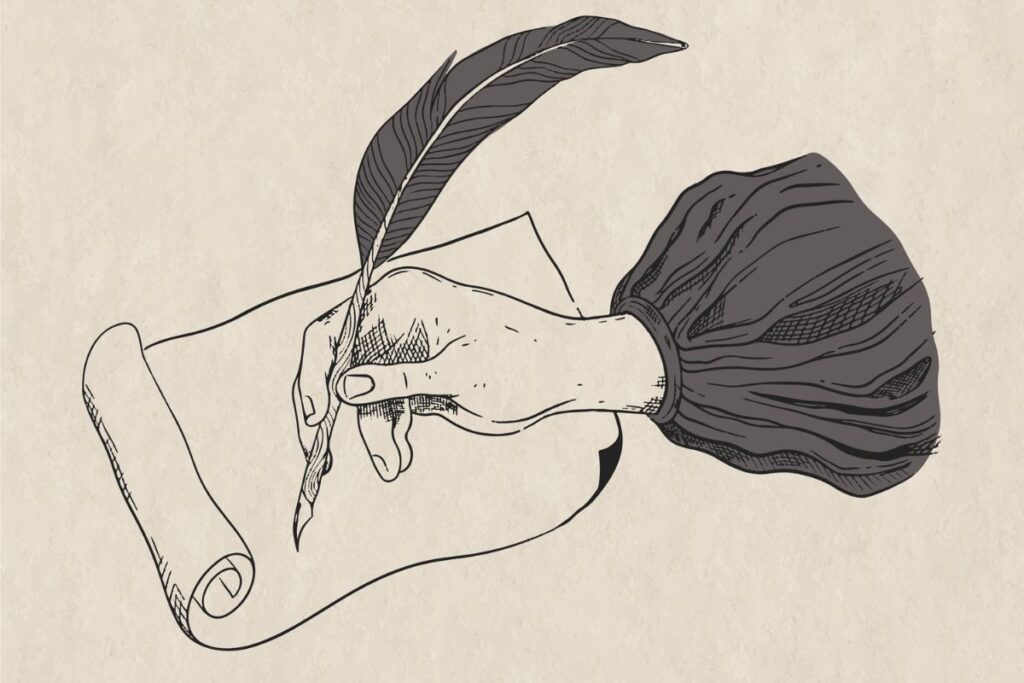
Now that you know the famous types of poetry, I know you’re wondering, “which one should I actually write?” Frankly, this is the poet’s version of staring at a full wardrobe and saying, “I have nothing to wear.”
To be honest, you don’t choose a poetic structure because it looks nice on paper. You choose it because it matches the shape of what you’re trying to say.
If you’re sitting with a story, something dramatic, maybe a bit tragic, with characters, turning points, and a heartbeat of its own, you can’t squeeze it into a haiku.
That’s a job for a ballad, a narrative poem.
If what you’re working with is raw emotion of heartbreak, longing, loss, you should look towards a ghazal or elegy.
Want to write something clever or a little sarcastic? Try a limerick or give an acrostic poem a shot.
When you really want to celebrate something (which could even be your morning coffee, by the way), write an ode.
And for times when you’re in that weird creative space where the ideas are coming, but nothing wants to rhyme or line up neatly, you can always lean into free verse.
Let the tone and intention guide your choice. And you can always write the same piece in multiple forms to see which one brings it to life.
If you want to explore different poetic forms without feeling overwhelmed, you can try our Undetectable AI’s Poem Generator.
It lets you enter a theme, mood, or idea and instantly shows how that same thought would look as a haiku, limerick, free verse piece, or even a sonnet.
This is a simple way to experiment with structure before committing to your final version, especially when you are unsure which form fits the emotion you want to express.
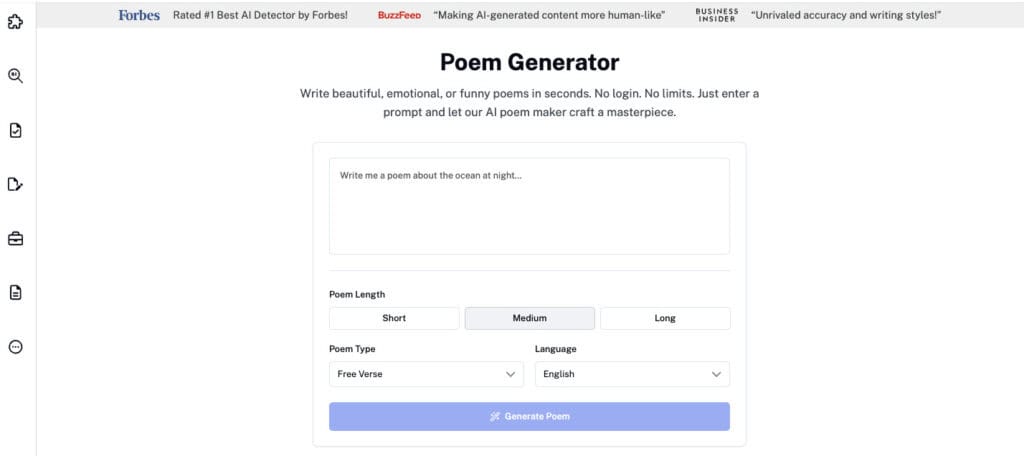
How Undetectable AI Tools Can Help Poets
Writing poetry from scratch is beautiful, but it’s also kind of brutal.
You start with a spark of emotion or a line that hits just right, and then spend 45 minutes in search of a word that rhymes well with your theme.
Any form of art, including poetry, can be amplified using AI tools.
And no, we’re not talking about handing over your art to a robot, but rather the suite of Undetectable AI tools that work like your writing assistant with your own creativity and flair.
Simply open up Undetectable AI Chat, give it the type of poetry you want (let’s say, “a sonnet poem about the first high school dance”), and throw in some emotional tone, i.e., the awkwardness and thrill that came with it.
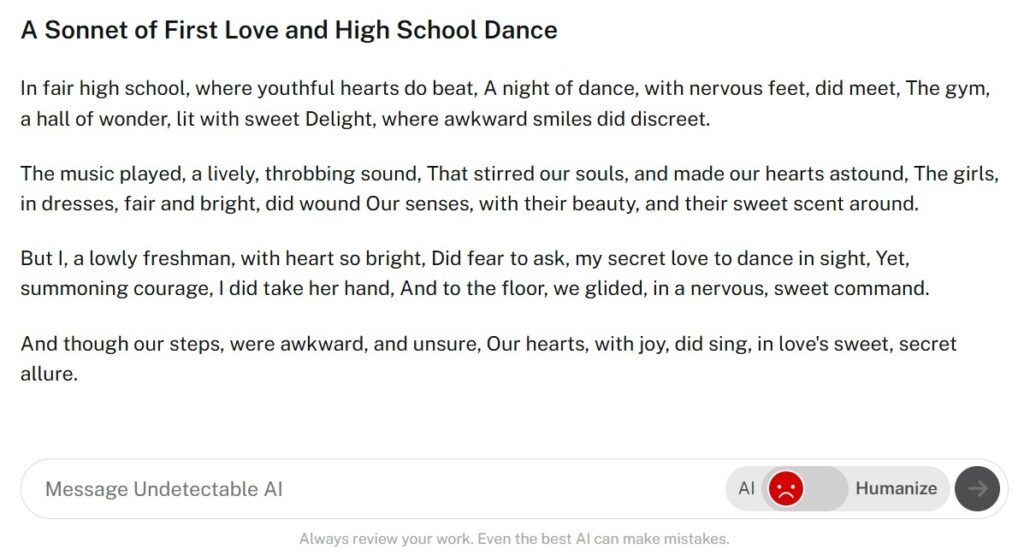
It is also pretty natural to feel that some lines in your poems are just a little too cliché, or clunky, or awkwardly forced.
The Undetectable AI Paraphraser is built for exactly those moments. You can feed it the phrase and get more poetic, cleaner versions without stripping your meaning.
The Undetectable AI Word Counter lets you plug in your lines and get a syllable count instantly, which is a lifesaver for structured poetry forms like haikus and sonnets.
Finally, if you’ve used AI tools to brainstorm or draft your poem, but now you’re submitting it to a writing contest or publication, you really don’t want it flagged by an AI detector.
Use the AI Detector and Humanizer to check how your poem would score on standard AI detection platforms and then humanize it.
It takes care of word patterns that may trigger AI flags while keeping the soul and originality intact.
Scroll down and see what our AI Detector and Humanizer can do!
FAQs About Types of Poetry
How many types of poetry are there?
There are over 150 types of poetry globally from different cultures, though, only about 20 of them are famous worldwide and are commonly used.
What is the easiest type of poem to write?
Free verse is often the easiest type of poem to write because it has no strict rules for rhyme, rhythm, or structure.
Can AI help me write poetry?
Yes, AI can help you write poetry, but it needs detailed prompts to capture your intent. And you should also humanize the output to add emotional depth.
Can AI-generated poetry be detected?
Yes, AI-generated poetry can be detected by AI detectors. However, if you humanize the poem, it’s possible to bypass detection and retain a natural, authentic voice.
What are the most popular poetry forms today?
Today, some of the most popular poetry forms include free verse, spoken word, haiku, and sonnets.
Conclusion
The beauty of poetry is that it can take on a hundred different shapes. And when you’re actually trying to write a poem, you’re not expected to nail it in one go.
Even the best poets struggle with the right phrasing and imagery before they end up with something that hits beautifully.
Undetectable AI is built for poets who want a hand without giving up their voice.
Its suite of tools will help you in composing different types of poetry and smooth out lines that don’t sound right, count syllables for structured forms, and humanize AI-assisted drafts.
Try Undetectable AI today.
